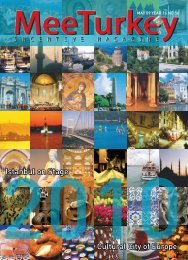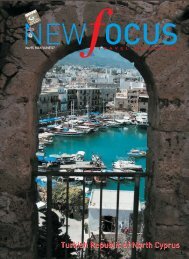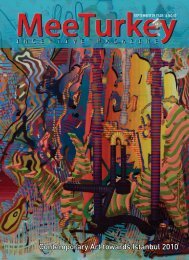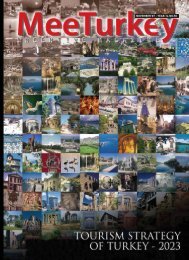Ä°zmir and ÃeÅme Peninsula * Focus on Ä°zmir Hotels - S&M ...
Ä°zmir and ÃeÅme Peninsula * Focus on Ä°zmir Hotels - S&M ...
Ä°zmir and ÃeÅme Peninsula * Focus on Ä°zmir Hotels - S&M ...
You also want an ePaper? Increase the reach of your titles
YUMPU automatically turns print PDFs into web optimized ePapers that Google loves.
ocus <strong>on</strong> DESTINATION<str<strong>on</strong>g>and</str<strong>on</strong>g> İkiçeşmelik), to the seashore al<strong>on</strong>gthe K<strong>on</strong>ak Square. It remains <strong>on</strong>e of theliveliest parts of İzmir.The first step thatpaved the way for the emergence ofthe present-day Kemeraltı area was thebuilding in 1592 of Hisar Mosque. It isthe oldest <str<strong>on</strong>g>and</str<strong>on</strong>g> <strong>on</strong>e of the most significantOttoman l<str<strong>on</strong>g>and</str<strong>on</strong>g>marks in İzmir, although builtby Aydınoğlu Yakup Bey, a descendant ofthe dynasty that had founded the Beylikof the same name (Aydınoğlu) whichhad c<strong>on</strong>trolled İzmir prior to the Ottomanc<strong>on</strong>quest. The name of the mosque, whichmeans “fortress”, makes reference to theGenoese castle of “San Pietro”, previouslycalled Ne<strong>on</strong> Kastr<strong>on</strong> in Byzantine times,part of which used to st<str<strong>on</strong>g>and</str<strong>on</strong>g> <strong>on</strong> the samelocati<strong>on</strong> <str<strong>on</strong>g>and</str<strong>on</strong>g> which gradually disappearedin whole with the c<strong>on</strong>structi<strong>on</strong> of newbuildings <strong>on</strong> its spot. The final remainsof the castle were cleared up during thec<strong>on</strong>structi<strong>on</strong> of new port installati<strong>on</strong>sbetween 1867-1876. The court of the1744-built Kızlarağası Han (caravanserai),with 1592-built Hisar Mosque in thebackground, in Kemeraltı, K<strong>on</strong>ak, İzmir.The caravanserai is a cultural center <str<strong>on</strong>g>and</str<strong>on</strong>g>a touristic attracti<strong>on</strong> today. The marketitself came into existence with the fillingbetween 1650-1670 of the shallowestparts of the inner bay. The processof gaining ground from the bay waspursued in 1744 with the c<strong>on</strong>structi<strong>on</strong>of Kızlarağası Han, a still-st<str<strong>on</strong>g>and</str<strong>on</strong>g>ingimpressive caravanserai that emergedas the nucleus of the market, togetherwith two older “hans”, the term implying acaravanserai with more markedly urbancharacteristics, that could not reach ourday. These were the “Great Vezir Han”c<strong>on</strong>structed by the 17th century gr<str<strong>on</strong>g>and</str<strong>on</strong>g>vizier Köprülü Fazıl Ahmed Pasha, <str<strong>on</strong>g>and</str<strong>on</strong>g> theneighboring “Little Vezir Han” c<strong>on</strong>structedby his successor Merzif<strong>on</strong>lu Kara MustafaPasha. Another historically important <str<strong>on</strong>g>and</str<strong>on</strong>g>no l<strong>on</strong>ger existing <strong>on</strong>e was “Cezayir Han”(literally “Han of Algiers”), from wherewestern Anatolia’s excess labor force hadbeen annually dispatched to the Ottomanprotectorate of Algiers for centuries. Infact, am<strong>on</strong>g the hundred odd “hans”Kemeraltı counted until the beginning ofthe 20th century, clearly visible <strong>on</strong> a 1905map drawn by French cartographers<strong>on</strong> behalf of internati<strong>on</strong>al insurancecompanies, <strong>on</strong>ly a dozen remains, infull or in part, while most was destroyedduring the 1922 Great Fire of Smyrna orafterwards.The remaining part of the innerbay being allowed to silt up progressivelythroughout the 18th century, the shorelinefacing Kemeraltı took its present straightform in the beginning of the 19th, althoughsome of the l<str<strong>on</strong>g>and</str<strong>on</strong>g> al<strong>on</strong>g the berth remainedunused until the end of that century. In1829, Sarı Kışla, the Yellow Casern,the principal Ottoman casern of the city,gigantic for its time, was built at immediatesea-side, <str<strong>on</strong>g>and</str<strong>on</strong>g> a private residence (k<strong>on</strong>ak)situated slightly diag<strong>on</strong>ally behind thecasern was extended <str<strong>on</strong>g>and</str<strong>on</strong>g> c<strong>on</strong>verted intothe governor’s mansi<strong>on</strong>, demarcatingK<strong>on</strong>ak Square that holds its name fromthe mansi<strong>on</strong>, <str<strong>on</strong>g>and</str<strong>on</strong>g> which in its turn gavethe name to the central metropolit<str<strong>on</strong>g>and</str<strong>on</strong>g>istrict of İzmir (K<strong>on</strong>ak) <str<strong>on</strong>g>and</str<strong>on</strong>g> at the level ofwhich Kemeraltı is c<strong>on</strong>sidered to start. Thegovernor’s mansi<strong>on</strong> still st<str<strong>on</strong>g>and</str<strong>on</strong>g>s, althoughthe Yellow Casern was demolished in1955 under express instructi<strong>on</strong>s from thethen Prime Minister Adnan Menderes, whowanted to see K<strong>on</strong>ak Square re-shaped,to the <strong>on</strong>going regret of many Smyrniotswho had come to adopt the oversizebuilding as <strong>on</strong>e of the main l<str<strong>on</strong>g>and</str<strong>on</strong>g>marks oftheir city.What to Eatİzmir’s cuisine has largely been affected by its multiculturalhistory, hence the large variety of food originating from theAegean, Mediterranean <str<strong>on</strong>g>and</str<strong>on</strong>g> Anatolian regi<strong>on</strong>s. Another factoris the large area of l<str<strong>on</strong>g>and</str<strong>on</strong>g> surrounding the regi<strong>on</strong> which growsa rich selecti<strong>on</strong> of vegetables. Some of the comm<strong>on</strong> dishesfound here are tarhana soup (made from dried yoghurt <str<strong>on</strong>g>and</str<strong>on</strong>g>tomatoes), İzmir köfte, keşkek (boiled wheat with meat), zerde(sweetened rice with saffr<strong>on</strong>) <str<strong>on</strong>g>and</str<strong>on</strong>g> mücver (made from zucchini<str<strong>on</strong>g>and</str<strong>on</strong>g> eggs).Historically, as a result of the influx of Greekrefugees from İzmir (as well as from other parts of Asia Minor<str<strong>on</strong>g>and</str<strong>on</strong>g> Istanbul) to mainl<str<strong>on</strong>g>and</str<strong>on</strong>g> Greece after 1922, the cuisine ofİzmir has had an enormous impact <strong>on</strong> Greek cuisine, exportingmany sophisticated spices <str<strong>on</strong>g>and</str<strong>on</strong>g> foods. You can also find manykind of Aegean sea fishes <str<strong>on</strong>g>and</str<strong>on</strong>g> excellent seafood restaurants.We recommend you Deniz Restaurant, 188 Ataturk cad. Izmir.Tel:+90 232 464 44 99- +90 422 06 01Where to stayYou can find variety of accommodati<strong>on</strong> facilities for all budgetsin Izmir <str<strong>on</strong>g>and</str<strong>on</strong>g> Cesme peninsula.In Izmir we recommend you ;18May / June ’09













